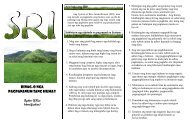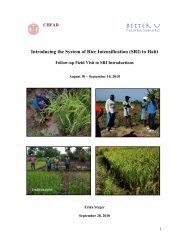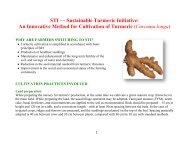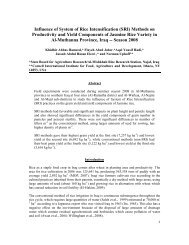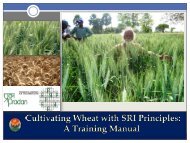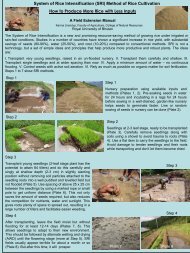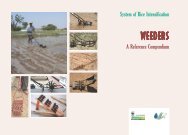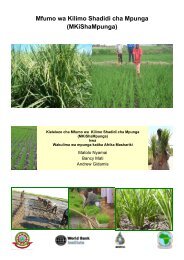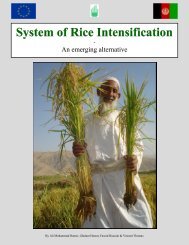EFFECT OF THE SYSTEM OF RICE INTENSIFICATION (SRI) ON ...
EFFECT OF THE SYSTEM OF RICE INTENSIFICATION (SRI) ON ...
EFFECT OF THE SYSTEM OF RICE INTENSIFICATION (SRI) ON ...
Create successful ePaper yourself
Turn your PDF publications into a flip-book with our unique Google optimized e-Paper software.
Table 8. An estimated picture of an annual nutrient budget for the target farmers. All nutrient values are in<br />
kg/ha. Kundu & Ladha (1999) refer to Koyama (1981) stating that upon applying organic materials 10-20% of<br />
the N is mineralized and thus plant available, and the rest is immobilised and lost. An average value of 15%<br />
mineralized N, P and K has been chosen. Nutrient inputs from sediments have not been included as no natural<br />
flooding occurred in the target area.<br />
N P K<br />
Input<br />
(Kg/ha) (Kg/ha) (Kg/ha) Specifications References<br />
Precipitation 12 0,2 12 Greenland (1997)<br />
Biological N fixation (BNF): mainly<br />
Azolla 30<br />
Dobermann & Fairhurst (2000)<br />
Seedling uptakes estimated to be 2% of straw of<br />
Transplanted seedlings (30 days)<br />
0,6 0,08 1,4<br />
5.25 t/ha. Uptake rates determined from De Datta<br />
(1987)<br />
N (1,67%), P (0,83%) and K (1,66%) of the<br />
Compost incl. GM 50 25 49,8 3t/ha<br />
compost estimated from Latif et al. (2005)<br />
Total 92,6 25,28 63,2<br />
Output<br />
Grain 38 7 11 3,5 t/ha grain yield Uptake rates estimated from De Datta (1987)<br />
Straw 26,6 3,8 67,5<br />
Leaching (percolation)<br />
Gaseous loss: Volatalization &<br />
20 1 10<br />
denitrification 4<br />
Total 88,6 11,8 88,5<br />
Net balance 4 13,48 - 25,3<br />
5,25t/ha dry<br />
weight<br />
Harvest Index 0,5 estimated from Dobermann &<br />
Fairhurst (2000). 5% from stubble not removed.<br />
Uptake rates estimated from De Datta (1987)<br />
Estimated from Dobermann & Fairhurst (2000) and<br />
N loss from leaching George et al. (1992)<br />
Estimated from Greenland (1997)<br />
9.6. Can <strong>SRI</strong> mitigate GHGs and at the same time increase soil quality<br />
through C sequestration?<br />
There are large differences between the theoretical concepts of <strong>SRI</strong> as described by Laulanie<br />
(1993), Stoop et al. (2002) and Sheehy et al. (2004) and the <strong>SRI</strong> conducted by the farmers in the<br />
target area of this study. This section will try to evaluate the consequences of the conceptual <strong>SRI</strong><br />
and the <strong>SRI</strong> conducted by the farmers in Prey Veng.<br />
Table 10 is a theoretical model illustrating how a theoretical <strong>SRI</strong> system as described by Stoop et al.<br />
(2002) and Sheehy et al. (2004) and the <strong>SRI</strong> practiced by farmers potentially will affect emissions<br />
of CH4, N2O and CO2 and influence the soil C pool.<br />
The use of a fluctuating water table resulting in periods of drainage and moist soils (Laulanie, 1993;<br />
Sheehy et al. 2004) will result in long periods with aerobic conditions reducing CH4, which though<br />
will lead to increased emissions of N2O but at the same time increase C content. SOM will therefore<br />
65



